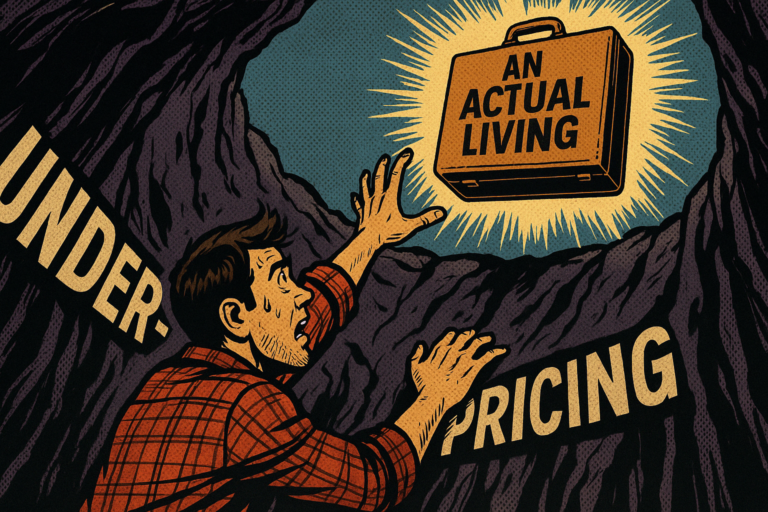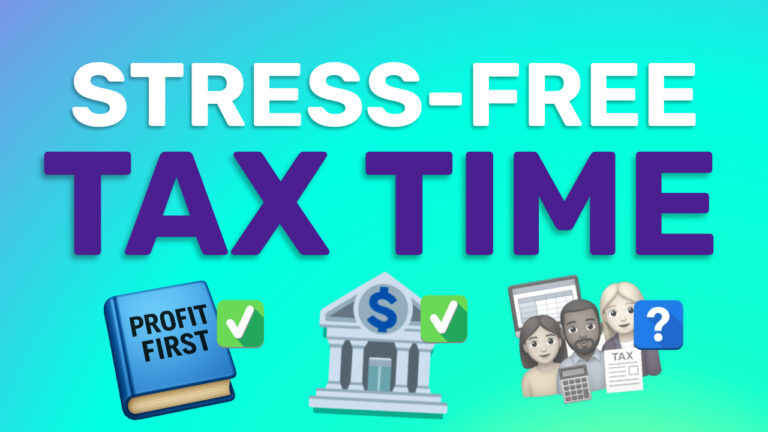Earlier this year a friend of mine who does a good chunk of side work sent me a screenshot of his estimated refund on TurboTax. And it was negative $18,000. As in, he owed the government 18 grand. Today I’m going to teach you how to not be my friend. I mean, not be like him. At least when it comes to his tax bill. Otherwise he’s really cool and you should absolutely want to be like him. You know what I mean. Roll the stinger.
Fact. Self-employment can offer a lot of great benefits. Like flexibility, time freedom, creative control (if you’re into that sort of thing) and ownership of your ideas, and overall satisfaction – knowing you own your own business and you can use it to make an impact and create opportunities for you and your family.
Fact. Regular ol’ fashioned employment can offer a lot of great benefits as well. Like stability, back office support, health insurance, paid time off, and other perks.
But these different sets of benefits don’t have to be mutually exclusive. With a little planning, you, yes YOU! Ms. Freelance Videographer, and Mr. Baking-as-a-hobby-turned-growing-home-based-business, you can build your own benefits package, predictable income, and peace of mind.
This is part 2 of a 3 part series covering the “Unholy Trinity of Trepidation” or the “Trifecta of Travail”, or the Big 3 most costly benefits that self-employed folks risk losing and might even stop in their tracks on their way to full-time entrepreneurship because they don’t know how they would replace and manage these 3 things on their own: Paid Time Off, Taxes, and Health Insurance.
In Part One, we talked about Paid Time Off, and how to make sure you can take a day off without worrying about falling off a cliff. I also talked a little about how to price yourself appropriately. Because this stuff costs money. When you’re working for an employer, they aren’t just giving you a paycheck, they’re giving you a bunch of other goodies, and they’ve priced your compensation and all of their other operating expenses into the cost of their goods and services. You need to do the same thing. Be sure to check out that video, because that lays the foundation for how you’re going to pay for everything that follows.
Today we’re going to talk about a very unsexy, and often overlooked benefit – Tax Liability.
Understanding Self-Employment Taxes
Your salary is subject to a 12.4% social security tax and a 2.9% Medicare tax. 15.3% in all for what is often referred to as FICA tax (for Federal Insurance Contributions Act). This is separate from federal and state income taxes. That gets calculated later. But did you know that employers are responsible for covering half of their employees’ FICA taxes? So you actually only pay 6.2% and 1.45% for Social Security and Medicare respectively, and your employer picks up the tab for the remaining half. So not only does your employer take care of all the paperwork, withhold your taxes from your paycheck and make required payments to the IRS on your behalf, they also let you take home an additional 7.65% of your salary – that could be thousands of dollars. Kinda makes you want to send your old finance department a cookie tray or something.
But when you are self-employed, you don’t have anyone covering the employer’s share of FICA taxes. For any money you earn as a non-employee or independent contractor you are on the hook for the full 15.3%. This is what we call Self Employment taxes. It’s all the same thing. The only thing that changes is who is paying. This why new freelancers usually will have an unpleasant experience filing their taxes after their first year of earning some self-employment income.
Climbing the Ladder of Self-Employment Tax Enlightenment
Remember my friend with the $18,000 tax bill. Fortunately, after he plugged in all of his expenses, things evened out. I think he even got a refund. But let’s talk about some things he could have done to avoid a lot of despair and heart palpitations, and how he might be able to save a chunk of change on next year’s tax bill.
I have to let you know, I am not an accountant or a tax attorney – so I’m not going to go into the nitty gritty of how to handle your taxes – this is not financial advice, you should definitely consult with a tax professional if you have any questions. But I’m going to present to you now a ladder of different steps you can take, different concepts you might consider doing more research on to start moving towards self-employment tax enlightenment. We’ll start with some super basic moves that many of you have probably already taken, and work our way up to some advanced judo for the more daring amongst you.
And I will present these steps in the best way I know how – through the Vince McMahon reaction meme.
#1 – Open a separate bank account

Don’t mingle your personal finances with your business finances. Deposit all of your income into a new business checking account, and and pay for all of your expenses out of this account. Likewise, get a separate business credit card and use it to pay for all of your business expenses. Note: Do NOT put any personal expenses on your business card. As tempting as it might be to pay for your home internet or phone bill to take advantage of a nice cashback category, don’t do it. Keep it clean.
#2 – Do some simple bookkeeping

Stay on top of tracking your income and expenses. Use a spreadsheet or software – I like Fiverr Workspace (formerly And.CO) and Bonsai – in addition to expense tracking they also handle invoicing, proposals, contracts, time tracking, and more – but there’s a TON of other tools you can check out. Categorize your expenses, because you’re going to be quizzed on that later when it comes time to file your taxes. Office supplies, advertising, professional fees, etc. Most software will have these categories preset for you to choose from and they typically (hopefully) match up with the expense categories on your tax forms.
The better you can keep up with your books, the less of a headache you’ll have to endure come next spring.
#3 – The Profit First Method

Open up more bank accounts. 4 more to be precise (at least to get started). You’ll deposit all of your income into your first account and then divvy that up into a “Profit” account, an “Owner’s Pay” account, an “Operating Expenses” account, and a “Tax” account. I have another video that dives deeper into how all of these accounts work and why they work – you can check that out here. But the key here – if you implement only one small piece of the Profit First method – is to set your taxes aside every time you get a paycheck. You can do some math to figure out the best percentage for you, but if you’re like me and you don’t have a ton of business expenses to drive down your net income, I’d set aside 25-30% of your income in a separate account. Fortunately this wasn’t the case for my woefully underprepared friend, but imagine finding out you owe the IRS $18,000, but you already spent it on a downpayment for a swimming pool and plane tickets to fly your parents in for the pool dedication ceremony. That would be what we call in the industry, a sicky situation.
The Profit First method helps assure you have money in the bank to cover your tax bill.
#4 – Automate Your Quarterly Estimate Payments

You might consider this less of an achievement to unlock and more of a pain in the tookus. But quarterly estimated tax payments don’t get the respect they deserve for making our lives a tad bit easier. Especially if you know how to handle it correctly, which I didn’t always know how to do. I have a video for that as well. Be sure to check that out, because I’m not going to spend a lot of time on this now except to say, you can set up your quarterly payments to be processed automatically throughout the year – paying them out of your designated tax account – and then when it comes time to file your taxes, instead of having to painfully part with a big chunk of money, there’s a better chance you’ll find out that you overpaid and you can get some money back for a change.
#5 – S-Corp Election

Everything up to this point you can do as a sole proprietorship OR an LLC. For this step, you have to get yourself incorporated. Quick word on LLCs – Out of the box, an LLC won’t help you when it comes to taxes. But it does provide some legal protection. It creates what’s called a “corporate veil” between your business and your personal life and assets. So in the unfortunate event someone wanted to sue your business, they could only come after your business assets. Without that layer of distinction and protection, your personal wealth, your house, and other assets are all exposed. So LLCs are not necessary, especially if you are just starting out, but they are a very good idea if you are going full time and doing business with people you don’t know and trust. An S-Corp election is a special tax status that you stick on top of your LLC. When you do that, you open up a whole box of chocolates. And the creamiest, carmeliests, nuttiest, ganachiest bon bon of them all is the ability to pay yourself as an employee.
Why does that matter?
S-Corporations Explained
Remember how your old employer used to cover half of your social security and medicare taxes? But then you quit your job to start living your dream, but that meant you got stuck paying more taxes than you probably anticipated? Now you get to go back to work – for yourself. Let’s head to the kitchen.
When you are a Sole proprietorship or an LLC without an S-Corp election (also known as a disregarded entity), your business income all flows through to you. So while the law may see you and your business as two separate entities, and you have the corporate veil right here, the IRS does not. Any income your business receives – you sell a coaching package, or a box of muffins, or car wash – it all flows into same bucket. And because there is no distinction between employee and employer, you pay the full 15.3% for FICA taxes (or Self Employment Taxes). That’s what the blue water means.
But if you opt for an S-Corp election, your business gets paid, but then you have a couple different options for how that money gets to your personal bank account. S-Corporation owners can pay themselves a salary or take distributions. When you pay yourself a salary, you are acting as both the employer paying and the employee receiving payroll, so you pay both halves of the FICA tax liability and ultimately end up with the same blue 15.3% tax water. But distributions are not subject to FICA taxes – only federal and state income taxes! All of your business profits pass through to you just like it did before, but now you pay much less on self-employment taxes.
Very important note: You must pay yourself a “Reasonable Salary.” The IRS does not specify what that means exactly, but I’m sure if you tried to only pay yourself $1,000 a year while taking a $99,000 distribution, you’re going to get a nasty letter in the mail. So, be reasonable. You might be able to get away with 50/50. Some people recommend breaking down the different roles you serve in your business and calculating an appropriate compensation based on that. But bonus coolness: Whatever you do end up paying yourself for a salary can be written off as a business expense, lowering your year-end tax liability and putting even more money in your pocket.
Why would you not want to do this?
I’ll tell you why. Because it’s complicated. And you can get yourself in trouble if you don’t take great care to follow the rules, file all the right paperwork, keep clean books – or pay somebody else to do it for you. Which can get expensive. But there are some affordable options that you should check out if you are interested in pursuing an S-election and unlocking some juicy tax savings.
Formations Corp makes it easy
I signed up with Formations Corp over a year ago now when I made the jump into full-time self-employment. And it’s been wonderful. I should do a deep dive in a future video, but my nutshell review: Give them a call. They take care of everything from filing your LLC and S-Corp paperwork, calculating your reasonable salary, running payroll, bookkeeping, monthly financial reports, filing your annual business tax returns, and you have a team of experts on call who can answer any of your questions and help you navigate business tax weirdness instead of subjecting yourself to hours of Google pain and frustration. I got in pretty early, and I think they’ve since raised their prices, I believe it’s $350 a month now, but that’s still very reasonable for everything you get – especially considering that you will very likely save more in taxes than it costs to pay for their services, it’s like you’re hiring your own finance back office for free.
Now again, this is laser-eyes level stuff. If you’re just starting out, take it one step at a time. You probably don’t want to mess around with S Corp stuff until you are bringing in about 60 or 70K in pre-tax income. Depending on where you live and your tax filing status, that number could be less. Feel free to reach out to the guys at Formations and they will give you an honest assessment on whether or not an S election is a good move for you right now.
Wrapping it up
Wherever you’re at and whatever you do, don’t not think about taxes. They are not fun. They can be complicated. There’s better things to do with your time. But ignoring the tax stuff until the last minute is going to come back to bite you in the butt, and you could be missing out on some really great opportunities.
For the third and final installment of this mini-series because I will be talking about Health Insurance. So pray for me while I prep that one.
Don’t be scared. This stuff can seem confusing and intimidating. But don’t let it hold you pack from pursuing your passion! It’s all figure-outable. I mean, I figured it out, so you can absolutely figure it out as well. And if you need a little help along the way, don’t hesitate to reach out.
That’s what sidekicks are for.


